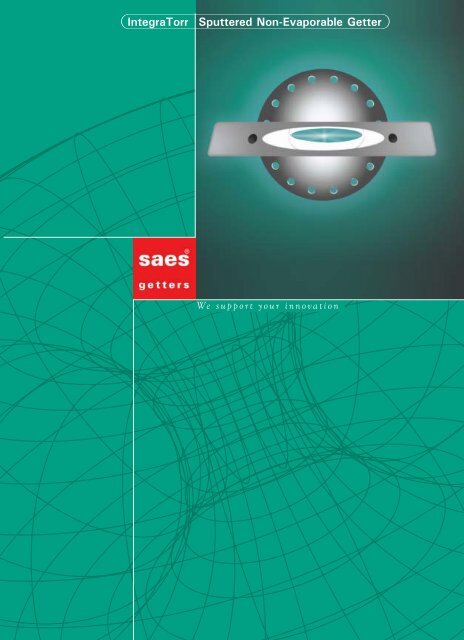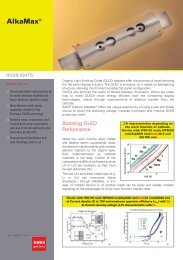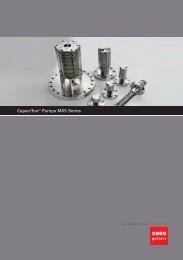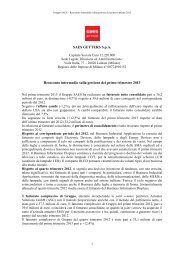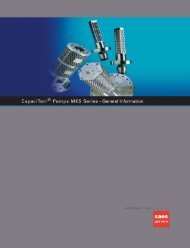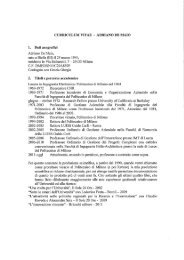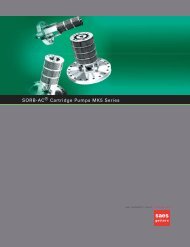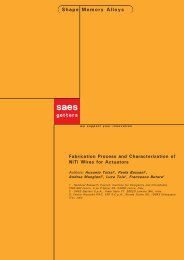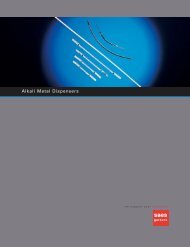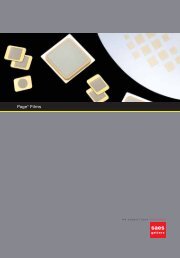integratorr brochure.pdf - SAES Getters
integratorr brochure.pdf - SAES Getters
integratorr brochure.pdf - SAES Getters
- No tags were found...
Create successful ePaper yourself
Turn your PDF publications into a flip-book with our unique Google optimized e-Paper software.
IntegraTorr Sputtered Non-Evaporable GetterWe support your innovation
IntegraTorr Sputtered Non-Evaporable GetterHIGHLIGHTSCourtesy of European Synchrotron Radiation FacilityGeneral FeaturesTrue high speed distributed pumpingHigh total pumping speedSimpler vacuum chamber geometry (no need forantechambers for pumping and reduction ofexternal ports)Activation achieved with a low-temperaturebaking process (180 °C)Drastic decrease of thermal andphoton-induced outgassingReduction of conditioning time andbremsstrahlungLower Secondary Electron YieldMultiple air exposure and reactivation possibilityIntegrating Vacuum Pump with Vacuum ChamberThe technique of sputtering thin-film coatings of Non-Evaporable <strong>Getters</strong>(NEG) for use as vacuum pumping for particle accelerators was originallydeveloped and patented at CERN, in order to meet specific needs whichemerged in the Large Hadron Collider (LHC) project. Thanks to a specificlicense agreement, and after a successful technology transfer process, thistechnology is now commercially available under the brand name ofIntegraTorr through the <strong>SAES</strong> <strong>Getters</strong> Group.IntegraTorr is a revolutionary way to integrate non-evaporable getter pumpinginto a particle accelerator vacuum chamber. It is achieved by depositing aSputtered Non-Evaporable Getter (SNEG) coating onto the surface of thevacuum chamber. The result is that the surface of the vacuum chamber,normally an outgassing source, becomes a vacuum pump.IntegraTorr thus provides an ideal UHV pumping solution, especially for thehighly conductance-limited vacuum chambers, such as those utilized in InsertionDevices.ApplicationsParticle AcceleratorsHeavy Ion RingsSynchrotron Radiation FacilitiesInsertion DevicesBeam LinesFrom Discrete Pumps to SNEG CoatingsIt is possible to identify a typical evolution in the pumping approach ofaccelerator vacuum chambers. The start phase involved the use of discretepumps, mounted at defined intervals along the chamber length.This evolved to the development of distributed pumping solutions especiallyuseful for narrow andconsequently, conductance-limited vacuum chambers,as those used in electron storage rings and synchrotron light sources.NEG materials in the form oflumped pumps or distributedstrips have found widespreaduse in particle acceleratorDiscrete Pumpingvacuum technology, due toeffectiveness and simplicity ofimplementation. The coating ofthe inner surface of theaccelerator vacuum chamberwith a NEG film, which can beactivated with an in-situ bakingat moderate temperatures, is theDistributed Pumpinglatest step in this evolutionprocess.The evolution toward an"integrated" pumping solutionprovides many advantages overprevious pumping approaches,either based on the use ofdiscrete pumps (SIP, TSP orNEG), or on the utilization ofdistributed pumps (DIP, NEGstrip).Integrated Pumping
Typical PerformanceThe main function of IntegraTorr is to provide a means of pumping within a vacuumchamber. For this reason the basic indicator of the IntegraTorr performance is thepumping speed that can be achieved by the SNEG film, taking into account that thepumping performance is also a function of the substrate material, its condition andsurface characteristics. An additional parameter, which is of fundamental importancewith respect to the IntegraTorr performance, is the number of air exposures andsuccessive reactivations that the film can go through without an excessivedegradation of its pumping capability.Variation of pumping speed for CO as a function of the pumped quantity for a Ti Zr V film (squares)and for a very rough coating (circles). CERN data.Variation of the H 2 sticking factor for a 5 m thick Ti Zr V film as a function of the number ofactivation-air-venting cycles.
Courtesy of Sincrotrone - Trieste SCpAA Revolutionary Pumping SolutionThe IntegraTorr film is obtained by the cosputteringof titanium, zirconium and vanadium.This is a combination that guarantees the bestperformance in terms of oxygen solubility anddiffusivity. Temperatures as low as 180 °C appliedfor 24 hours during a standard in-situ bakingprocess are sufficient to fully activate this SNEGfilm. This allows the film to be deposited onvarious kinds of substrate materials including theones of relevance for particle acceleratorapplications such as stainless steel, copper andaluminum.Once activated, the film operates as a typical gettermaterial, removing the active gases which impingeon its surface. If the totality of the vacuum chamberis coated with this film, a true, fully distributedpump with huge pumping speed is achieved. Inaddition, the IntegraTorr active film provides aphysical barrier to the outgassing species comingfrom the substrate material. In these conditions, itis possible to achieve pressures in the eXtremeHigh Vacuum (XHV) range, below 1 x 10 -13 mbar.Advantages of the IntegraTorr ApproachDifferent morphology of a Ti Zr V film deposited on a stainlesssteel substrate kept at different temperatures (top 300°, bottom100°)Besides providing a true, fully distributed pumping system, the IntegraTorr coating film alsoreduces the degassing induced by ion, electron and photon bombardment, making it particularlysuitable for synchrotron radiation light sources.These features help also in shortening the conditioning time of newly installed vacuum chambersand, in addition, the improved vacuum conditions guarantee much lower bremsstrahlung.The adoption of the IntegraTorr also allows a much simpler chamber design without the need toadd frequent pumping ports for discrete pumping or separate antechambers for distributedpumping.Active SNEG films have been also demonstrated to have a lower Secondary Electron Yield,reducing the risks of multipacting phenomena.


